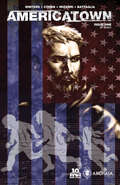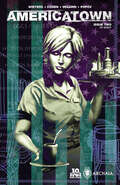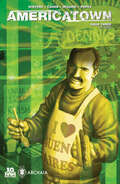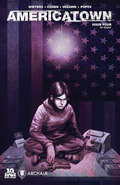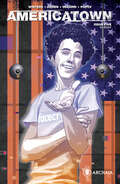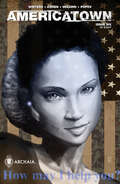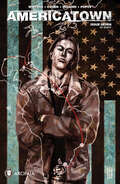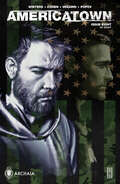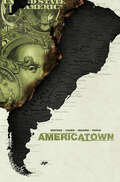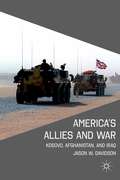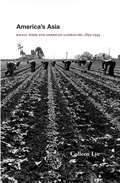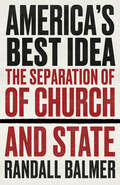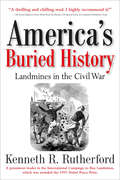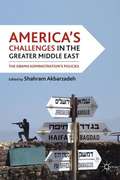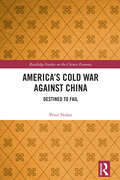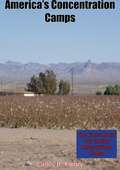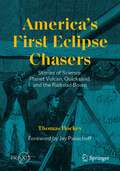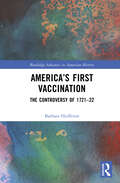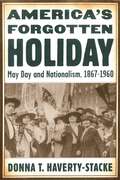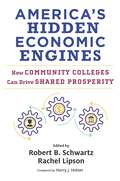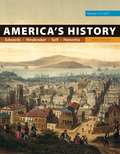- Table View
- List View
Americatown #1 (Americatown #1)
by Larry Cohen Bradford WintersWhat's to Love: Part social commentary, part family drama, Americatown asks: What if the American Dream gave way to the American Nightmare? In their inaugural comic series, screenwriters Bradford Winters (Oz, Boss, The Americans) and Larry Cohen (Netflix's Borgia), give us a story great for fans of Transmetropolitan, Children of Men, and the TV show Black Mirror.What It Is: After an economic collapse and other disasters in the near future, Americans are now the legal and illegal immigrants living abroad. They find work in cities like Buenos Aires, where their very own enclave known as "Americatown" has taken root. Owen, a recent arrival, begins a journey to support and save his splintered family divided between the enclave and home back in the U.S. His struggle is just a small part of the hardships and conflicting agendas in an immigrant community trying to build itself in the shadow of a once great nation.
Americatown #2 (Americatown #2)
by Larry Cohen Bradford WintersAs Owen struggles to survive in his new home, all he can think about is where his son might be.
Americatown #3 (Americatown #3)
by Larry Cohen Bradford WintersArroyo begins interrogating the undocumented Americans who were captured in a raid.
Americatown #4 (Americatown #4)
by Larry Cohen Bradford WintersOwen and Tonto mobilize towards Derek, but Agent Arroyo is looking for him, too.
Americatown #5 (Americatown #5)
by Larry Cohen Bradford WintersDigital Exclusive! Owen tries to get a message out to Derek who is recovering from Arroyo's assault in solitary confinement, while Tonto orders a house bugged by July 4th.
Americatown #6 (Americatown #6)
by Larry Cohen Bradford WintersDigital Exclusive! When Arroyo's partner slips into a coma, his quest becomes personal.
Americatown #7 (Americatown #7)
by Larry Cohen Bradford WintersDigital Exclusive! Owen's lawyer meets with Derek at the detention center and assures him that Owen has a plan.
Americatown #8 (Americatown #8)
by Larry Cohen Bradford WintersDigital Exclusive! The 4th of July arrives in Americatown, as does Tonto, with an offer Owen can't refuse.
Americatown (Americatown)
by Larry Cohen Bradford WintersPart social commentary, part family drama, Americatown asks: What if the American Dream gave way to the American Nightmare? In their inaugural comic series, screenwriters Bradford Winters (Oz, Boss, The Americans) and Larry Cohen (Netflix's Borgia), give us a story great for fans of Transmetropolitan, Children of Men, and the TV show Black Mirror. After an economic collapse and other disasters in the near future, Americans are now the legal and illegal immigrants living abroad. They find work in cities like Buenos Aires, where their very own enclave known as "Americatown" has taken root. Owen, a recent arrival, begins a journey to support and save his splintered family divided between the enclave and home back in the U.S. His struggle is just a small part of the hardships and conflicting agendas in an immigrant community trying to build itself in the shadow of a once great nation. Collects the complete limited series.
America’s Allies and War: Kosovo, Afghanistan, and Iraq
by Jason W. DavidsonWhy do Britain, France, and Italy provide or refuse military support for U. S. -led uses of force? This book provides a unique, multiple-case study analysis of transatlantic burden-sharing. Sixty original interviews with top policymakers and analysts provide insight into allies' decisions regarding the Kosovo War, Afghanistan, and the Iraq War.
America’s Arab Refugees: Vulnerability and Health on the Margins
by Marcia C. InhornAmerica's Arab Refugees is a timely examination of the world's worst refugee crisis since World War II. Tracing the history of Middle Eastern wars—especially the U.S. military interventions in Iraq and Afghanistan—to the current refugee crisis, Marcia C. Inhorn examines how refugees fare once resettled in America. In the U.S., Arabs are challenged by discrimination, poverty, and various forms of vulnerability. Inhorn shines a spotlight on the plight of resettled Arab refugees in the ethnic enclave community of "Arab Detroit," Michigan. Sharing in the poverty of Detroit's Black communities, Arab refugees struggle to find employment and to rebuild their lives. Iraqi and Lebanese refugees who have fled from war zones also face several serious health challenges. Uncovering the depths of these challenges, Inhorn's ethnography follows refugees in Detroit suffering reproductive health problems requiring in vitro fertilization (IVF). Without money to afford costly IVF services, Arab refugee couples are caught in a state of "reproductive exile"—unable to return to war-torn countries with shattered healthcare systems, but unable to access affordable IVF services in America. America's Arab Refugees questions America's responsibility for, and commitment to, Arab refugees, mounting a powerful call to end the violence in the Middle East, assist war orphans and uprooted families, take better care of Arab refugees in this country, and provide them with equitable and affordable healthcare services.
America’s Asia: Racial Form and American Literature, 1893-1945
by Colleen LyeWhat explains the perception of Asians both as economic exemplars and as threats?America's Asia explores a discursive tradition that affiliates the East with modern efficiency, in contrast to more familiar primitivist forms of Orientalism. Colleen Lye traces the American stereotype of Asians as a "model minority" or a "yellow peril"--two aspects of what she calls "Asiatic racial form"-- to emergent responses to globalization beginning in California in the late nineteenth century, when industrialization proceeded in tandem with the nation's neocolonial expansion beyond its continental frontier. From Progressive efforts to regulate corporate monopoly to New Deal contentions with the crisis of the Great Depression, a particular racial mode of social redress explains why turn-of-the-century radicals and reformers united around Asian exclusion and why Japanese American internment during World War II was a liberal initiative. In Lye's reconstructed archive of Asian American racialization, literary naturalism and its conventions of representing capitalist abstraction provide key historiographical evidence. Arguing for the profound influence of literature on policymaking, America's Asia examines the relationship between Jack London and leading Progressive George Kennan on U. S. -Japan relations, Frank Norris and AFL leader Samuel Gompers on cheap immigrant labor, Pearl S. Buck and journalist Edgar Snow on the Popular Front in China, and John Steinbeck and left intellectual Carey McWilliams on Japanese American internment. Lye's materialist approach to the construction of race succeeds in locating racialization as part of a wider ideological pattern and in distinguishing between its different, and sometimes opposing, historical effects.
America’s Best Idea: The Separation of Church and State
by Randall BalmerA historian and ordained Episcopal priest offers everything you need to know for shaping and defending your own beliefs on the role of religion in American lifeFilled with stories from America's struggle for religious freedom most readers have never heard before and perfect for fans of Jesus and John Wayne and On TyrannyThe 1st Amendment to the US Constitution codified the principle that government should play no role in favoring or supporting any religion, while allowing free exercise of all religions (including unbelief). More than 200 years later, the results from this experiment are overwhelming: The separation of church and state has shielded the government from religious factionalism, and the United States boasts a diverse religious culture unmatched in the world.But changes have been taking place at an accelerating pace in recent years. The current Supreme Court has shifted away from excluding the influence and practice of religion at public institutions and in our laws and policies, and moved dramatically toward protecting the inclusion and promotion of religion in publicly funded undertakings.Moreover, adherents to a Christian Nationalism ideology have grown more vocal and emboldened, and are increasingly moving into positions of power.Randall Balmer, one of the premier historians of religion in America, reviews both the history of the separation of church and state and various attempts to undermine that wall. Despite the fact that the 1st Amendment and the separation of church and state has served the nation remarkably well, he argues, its future is by no means assured.
America’s Budget Impasse, 2001-2020
by Richard H.K. VietorThe United States has been a fiscal mess for years…at least since the financial crisis in 2009. This case describes the U.S. economy during the presidencies of Barack Obama, Donald Trump and now, Joe Biden’s first year. The case is composed of excerpts from the Economic Report of the President (2017), Resolution 209 (the Green New Deal), the Economic Report of the President (2018), the Budget Message (2023), and the Economic Report of the President (2022). Its purpose is to review the strengths and weaknesses of tax cuts, to understand fiscal stimuli, to deepen understanding of inflation, and to evaluate Biden’s agenda for 2022-24.
America’s Buried History: Landmines in the Civil War
by Kenneth R. RutherfordDespite all that has been published on the American Civil War, one aspect that has never received the in-depth attention it deserves is the widespread use of landmines across the Confederacy. These “infernal devices” dealt death and injury in nearly every Confederate state and influenced the course of the war. Kenneth R. Rutherford rectifies this oversight with America’s Buried History: Landmines in the Civil War, the first book devoted to a comprehensive analysis and history of the fascinating and important topic. Modern landmines were used for the first time in history on a widespread basis during the Civil War when the Confederacy, in desperate need of an innovative technology to overcome significant deficits in materiel and manpower, employed them. The first American to die from a victim-activated landmine was on the Virginia Peninsula in early 1862 during the siege of Yorktown. Their use set off explosive debates inside the Confederate government and within the ranks of the army over the ethics of using “weapons that wait.” As Confederate fortunes dimmed, leveraging low-cost weapons like landmines became acceptable and even desirable. The controversial weapon was the brainchild of Confederate General Gabriel J. Rains (who had experimented with explosive booby traps in Florida two decades earlier during the Seminole Wars, and other Confederates soldiers developed a sundry of landmine varieties, including command-controlled and victim-activated. The devices saw extensive use in Virginia, at Port Hudson in Louisiana, in Georgia, the Trans-Mississippi Theater, during the closing weeks of the war in the Carolinas, and in harbors and rivers in multiple states. Debates over the ethics of using mine warfare did not end in 1865, and are still being waged to this day. Dr. Rutherford, who is known worldwide for his work in the landmine discipline, and who himself lost his legs to a mine in Africa, relies on a host of primary and secondary research to demonstrate how and why the mines were built, how and where they were deployed, the effects of their use, and the reactions of those who suffered from their deadly blasts. America’s Buried History is an important contribution to the literature on one of the most fundamental, contentious, and significant modern conventional weapons. According to some estimates, by the early 1990s landmines were responsible for more than 26,000 deaths each year worldwide. Landmines, argues Dr. Rutherford, transitioned from “tools of cowards” and “offenses against democracy and civilized warfare” to an accepted form of warfare until the early 1990s. The genesis of this acceptance began during the American Civil War.
America’s Challenges in the Greater Middle East
by Shahram AkbarzadehBarack Obama has faced many challenges in reversing U. S. policy on the Middle East. This book highlights points of resistance to Obama's efforts regarding U. S. foreign policy and what lessons may be learned from this experience for the remainder of his presidency and his potential second term in office.
America’s Cold War against China: Destined to Fail (Routledge Studies on the Chinese Economy)
by Peter NolanThis book discusses how the USA has launched a new cold war against China.Showing how this New Cold War can only be fully understood by analysing the long-run history of the East and the West, and the fundamental differences between the Old and the New Cold Wars, this book outlines how the New Cold War focuses on issues connected with China’s territorial integrity: Xinjiang, the South China Sea, Hong Kong, Taiwan, and the closely connected conflict over semiconductors. It analyses the way in which China has responded to US-led Western aggression by following the approach suggested by Confucius: instead of ‘returning aggression with kindness’ or ‘returning aggression with aggression’, China has ‘returned aggression with firmness’. The book argues that the United States’ effort to establish hegemony over Eurasia has failed and that, in the face of this reality, there is no choice for the USA other than to cooperate with China in order to resolve the existential issues facing the human species.Demonstrating how US-led aggression has been rendered ineffective, this book will be a valuable resource to students and scholars of international relations and politics, including those in both China and the USA.
America’s Concentration Camps: The Facts About Our Indian Reservations Today
by Carlos B. EmbryIn this book, which was first published in 1956, Kentucky newspaper editor, publisher and writer Carlos B. Embry presents a detailed examination of the legal, political and socioeconomic status of Native Americans.“A devastating survey of the plight of the American Indian touches on the history that preceded the retreat to the reservations, the nature of the Indian Bureau and its seeming philosophy of perpetual paternalism, and tells the story of the tribes through the viewpoint of their leaders.”—Kirkus Review
America’s Dream Palace
by Osamah F. KhalilAs the postwar U.S. national security establishment required Middle Eastern expertise, it cultivated a beneficial relationship with universities. But by the time the Bush administration declared its Global War on Terror, Osamah Khalil shows, think tank agendas aligned with neoconservative goals were the drivers of America's foreign policy.
America’s First Eclipse Chasers: Stories of Science, Planet Vulcan, Quicksand, and the Railroad Boom (Springer Praxis Books)
by Thomas HockeyIn 2017, over 200 million Americans witnessed the spectacular total eclipse of the Sun, and the 2024 eclipse is expected to draw even larger crowds. In anticipation of this upcoming event, this book takes us back in history over 150 years, telling the story of the nation’s first ever eclipse chasers.Our tale follows the chaotic journeys of scientists and amateur astronomers as they trekked across the western United States to view the rare phenomenon of a total solar eclipse. The fascinating story centers on the expeditions of the 1869 total eclipse, which took place during the turbulent age of the chimerical Planet Vulcan and Civil War Reconstruction. The protagonists—a motley crew featuring astronomical giants like Simon Newcomb and pioneering female astronomers like Maria Mitchell—were met with unanticipated dangers, mission-threatening accidents, and eccentric characters only the West could produce. Theirs is a story of astronomical proportions. Along the way, we will make several stops across the booming US railroad network, traveling from viewing sites as familiar as Des Moines, Iowa, to ones as distant and strange as newly acquired Alaska.From equipment failures and botched preparations to quicksand and apocalyptic ‘comets’, welcome to the wild, western world of solar eclipses.
America’s First Vaccination: The Controversy of 1721-22 (Routledge Advances in American History)
by Barbara HeifferonThis book explores the response to a new scientific advance in medicine three hundred years ago to understand how this discourse revealed religious, racial, anti-intellectual, and other ideologies the first time documented vaccinations were introduced in America. This text serves as a case study that examines the historic discourses surrounding the implementation of a new prevention technique, smallpox inoculation, to prevent the devastating epidemics of smallpox that had visited the new colonies since their start on the American continent. Using this detailed analysis of the arguments surrounding the project in early America, the author examines the various arguments that circulated in the 1720s regarding the project. When compared to today’s pandemic, this study argues that Americans over-react and complicate scientific applications not with logical scientific perspectives or even with ethical views, but instead bring exaggerated claims founded on uniquely American historical, religious, racial, territorial, and political ideologies. America’s First Vaccination will be of interest to anyone interested in American history, the history of medicine, cultural studies, and a comparison to current pandemic events.
America’s Forgotten Holiday: May Day and Nationalism, 1867-1960 (American History and Culture #2)
by Donna T Haverty-StackeThough now a largely forgotten holiday in the United States, May Day was founded here in 1886 by an energized labor movement as a part of its struggle for the eight-hour day. In ensuing years, May Day took on new meaning, and by the early 1900s had become an annual rallying point for anarchists, socialists, and communists around the world. Yet American workers and radicals also used May Day to advance alternative definitions of what it meant to be an American and what America should be as a nation.Mining contemporary newspapers, party and union records, oral histories, photographs, and rare film footage, America’s Forgotten Holiday explains how May Days celebrants, through their colorful parades and mass meetings, both contributed to the construction of their own radical American identities and publicized alternative social and political models for the nation.This fascinating story of May Day in America reveals how many contours of American nationalism developed in dialogue with political radicals and workers, and uncovers the cultural history of those who considered themselves both patriotic and dissenting Americans.
America’s Geoheritage II: Identifying, Developing, and Preserving America’s Natural Legacy: Proceedings of a Workshop
by Board on International Scientific Organizations Policy and Global Affairs National Academies of Sciences, Engineering, and Medicine Planning Committee for America's Geoheritage II: Identifying, Developing, and Preserving America's Natural LegacyAmerica is endowed with places that embody a rich geoheritage, from sites where indigenous people subsisted for millennia, to mines that furnished the raw materials that built U.S. industry, to mountain ranges and river gorges with unparalleled recreational opportunities, to field sites where students can truly understand a geological process, to places of aesthetic or spiritual value, and many more across all states and territories. In order to assess the status of geoheritage and the activities of its practitioners in the United States in light of social, political, and environmental changes over the past ten years, the National Academies of Sciences Engineering and Medicine convened a series of virtual webinars and a workshop. From September to December 2020, a Distinguished Speakers Webinar Program composed of eight webinars provided an overview of geoheritage initiatives, as well as focused presentations on geoheritage related to federal and state lands, cultural heritage, education, research, and economic development and geotourism. In January 2021, 101 land managers, state geologists, educators, researchers, and members and staff of professional societies and nongovernmental organizations participated in a virtual writing workshop to aggregate and organize community input on strategies and best practices in developing geoheritage sites across the United States. The participants were divided into focus groups that roughly aligned with the topics explored in the fall 2020 workshops. The groups worked synchronously and asynchronously over the course of a week, then presented their ideas in a plenary session. This publication summarizes the presentations and discussion of the webinars and workshop.
America’s Hidden Economic Engines: How Community Colleges Can Drive Shared Prosperity (Work and Learning Series)
by Nancy HoffmanFive in-depth case studies reveal the innovative practices that position U.S. community colleges as pathways to quality employment. In America&’s Hidden Economic Engines, editors Robert B. Schwartz and Rachel Lipson spotlight community and technical colleges as institutions uniquely equipped to foster more equitable economic growth across America&’s regions. As Schwartz and Lipson show, these colleges are the best-placed institutions to reverse the decades-long rise in US economic inequality by race, class, and geography. In the book, Harvard Project on Workforce researchers introduce detailed case studies of five institutions—Lorain County Community College in Ohio, Mississippi Gulf Coast Community College, Northern Virginia Community College, Pima Community College in Arizona, and San Jacinto Community College in Texas—that show what is possible when governments, employers, and communities invest in their community colleges&’ economic and workforce development mission. These case studies reveal key institutional policies and practices, leadership behaviors, and organizational structures of successful collaborations between colleges and their regional partners in the public and private sector. Each case underscores how, although community colleges face distinct challenges based on local context, successful schools demonstrate a consistent focus on economic mobility and good jobs across all their programs and activities. In a concluding chapter, the editors champion community colleges as the most critical institutions for the future of US workforce development policy.
America’s History
by James A. Henretta Rebecca Edwards Robert O. Self Eric HinderakerKnown for its clear, insightful analytical narrative and balanced approach, America's History brings America's diverse past to life. An accessible and balanced narrative with built-in primary sources and skills-based pedagogy gives students practice in thinking historically.
